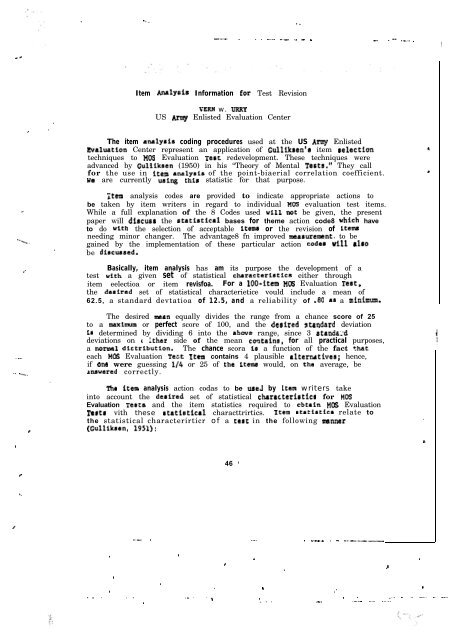Technical Report - International Military Testing Association
Technical Report - International Military Testing Association
Technical Report - International Military Testing Association
Create successful ePaper yourself
Turn your PDF publications into a flip-book with our unique Google optimized e-Paper software.
--<br />
.r<br />
. .<br />
“\.<br />
.._-.<br />
-.<br />
.- -__.<br />
,<br />
.<br />
-.<br />
,<br />
.<br />
.<br />
.<br />
.<br />
. --_ ._<br />
-----. - _ _ ._-._ -.._ ._ _ ^ .- . -- ._. _<br />
Item ~nalyrie Information for Test Revision<br />
VERN w. URRY<br />
US Arwy Enlisted Evaluation Center<br />
The item aMly8is coding procedures used at the US Army Enlisted<br />
Evaluation Center represent an application of Cullikren’e item &leCtion<br />
techniques to MOS Evaluation Test redevelopment. These techniques were<br />
advanced by Culliksen (1950) in his “Theory of Mental Tests.” They call<br />
for the use in item anrrlyeis of the point-biaerial correlation coefficient.<br />
Ws are currently using thir statistic for that purpose.<br />
XtCcP analysis codes are provided to indicate appropriate actions to<br />
be taken by item writers in regard to individual HOS evaluation test items.<br />
While a full explanation of the 8 Codes used vi11 not be given, the present<br />
paper will discuer the statistlcal bases for theme action code8 vhich have<br />
to do vith the selection of acceptable item or the revision of items<br />
needing minor changer. The advantage8 fn improved measurement3 to be<br />
gained by the implementation of these particular action code8 will al80<br />
be dircusscd.<br />
Basically, item analysis has am its purpose the development of a<br />
test vith a given set of statistical chararteristica either through<br />
item eelectioa or item revisfoa. For a lOO-item HOS Evaluation Test,<br />
the deeired set of statistical characterietice vould include a mean of<br />
62.5, a standard devtatioa of 12.5, and a reliability of .80 a6 a mFaimum.<br />
The desired mean equally divides the range from a chance score of 25<br />
to a mxinarm or perfect score of 100, and the derlred 1taadard deviation<br />
io determined by dividing 6 into the above range, since 3 atanda:d<br />
deviations on c ither side of the mean cmtaine, for all practical purposes,<br />
a normal dictribution. The chance scora ir a function of the fact that<br />
each l4m Evaluation Tec;t Item contains 4 plausible alterridtives; hence,<br />
if OM were guessing 11’4 or 25 of the item would, on the average, be<br />
msvered correctly.<br />
The it- analysis action codas to be useJ by iteta writers take<br />
into account the dcrlred set of statistical characteristica for NO!3<br />
Evaluation Tests and the item statistics required to cbtafn HOS Evaluation<br />
Tart8 vith these atatirtical characttrirtics. Item rtatisticr relate to<br />
the statistical characterirticr of a teat in the following annner<br />
(Culliksen, 1951):<br />
.<br />
.<br />
46 ’<br />
--. . __. . ..-- - - -_-_--<br />
.<br />
I<br />
e .<br />
.<br />
.<br />
.<br />
.<br />
.<br />
.<br />
:<br />
.<br />
_.. ,.<br />
‘-. .t .<br />
^I. .^_<br />
.<br />
.._.._ ^-<br />
. ..-<br />
.-.-<br />
- -- -- -. ---<br />
.<br />
#<br />
.<br />
.<br />
!









